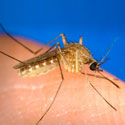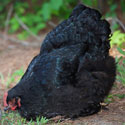
Scientists from Sweden and Ethiopia have discovered that malaria-causing mosquitoes don’t like the smell of chickens. Malarial mosquitoes avoid live chickens, as well as steering clear of compounds extracted from chicken feathers. Researchers are now investigating whether chicken-odor extract might be used as a malarial mosquito repellent, according to a recent BBC report.
Since the Zika virus has been making inroads in the United States, and is also carried by mosquitoes, one might jump to the conclusion that chickens could offer protection against Zika. Not so fast!
According to the CDC, mosquitoes are grouped into 41 genera, among which are some 3,500 different species. Malaria is transmitted only by females of the genus Anopheles. Of approximately 430 Anopheles species, no more than 40 species transmit malaria. Some malarial mosquitoes have developed resistance to the usual insecticides, so the possibility of chicken-odor extract as mosquito repellent could be great news in areas where malaria is a major issue.
Zika virus, however, is transmitted by mosquitoes in the genus Aedes, which are also responsible for transmitting dengue, chikungunya, and yellow fever viruses, according to the CDC. Of the 700 Aedes species, two species have been identified as capable of transmitting Zika.
Unlike Anopheles mosquitoes, which typically are active in the hours between dusk and dawn, Aedes mosquitoes bite mostly during the daytime, but may also bite at dusk and dawn. As well as infecting humans with several different viruses, Aedes mosquitoes have been implicated in infecting chickens with the avian pox virus. Obviously, therefore, they are not repelled by chickens.
Ten species of mosquitoes have been incriminated in the spread of avian pox.
While some are of the genera Aedes, others are of the genera Culex, which comprises 500 species. Like Anopheles mosquitoes, Culex mosquitoes are night biters.
Culex mosquitoes are sometimes called common house mosquitoes. They contribute to the spread of a number of human diseases including West Nile virus and St. Louis encephalitis. Culex mosquitoes are also known as bird biting mosquitoes, because they prefer avian species over humans.
After feeding on a single infected chicken, a mosquito can spread the pox virus to a several other chickens. Avian pox — which is not the same as chicken pox in humans — is the bane of poultry keepers. It can appear as one of two forms: dry pox affecting the skin (cutaneous form) and wet pox affecting the mucous membranes of the upper respiratory tract (diphtheric form).
Dry pox is the more common form. It appears as wartlike bumps on featherless skin, including the beak, comb, wattles, earlobes, and eyelids and sometimes on the legs and feet and around the vent. Dry pox typically occurs during the warmer months when mosquitoes are active and can be spread from chicken to chicken by mites.
In pox-prone areas the virus may be managed by controlling mosquitoes and mites, and through annual vaccination of the entire flock. Chicken odor and feather extracts may repel malarial mosquitoes, but don’t count on it to deter mosquitoes that spread Zika virus to humans or avian pox to chickens.
And that’s today’s news from the Cackle Coop.
Gail Damerow, author, The Chicken Health Handbook


